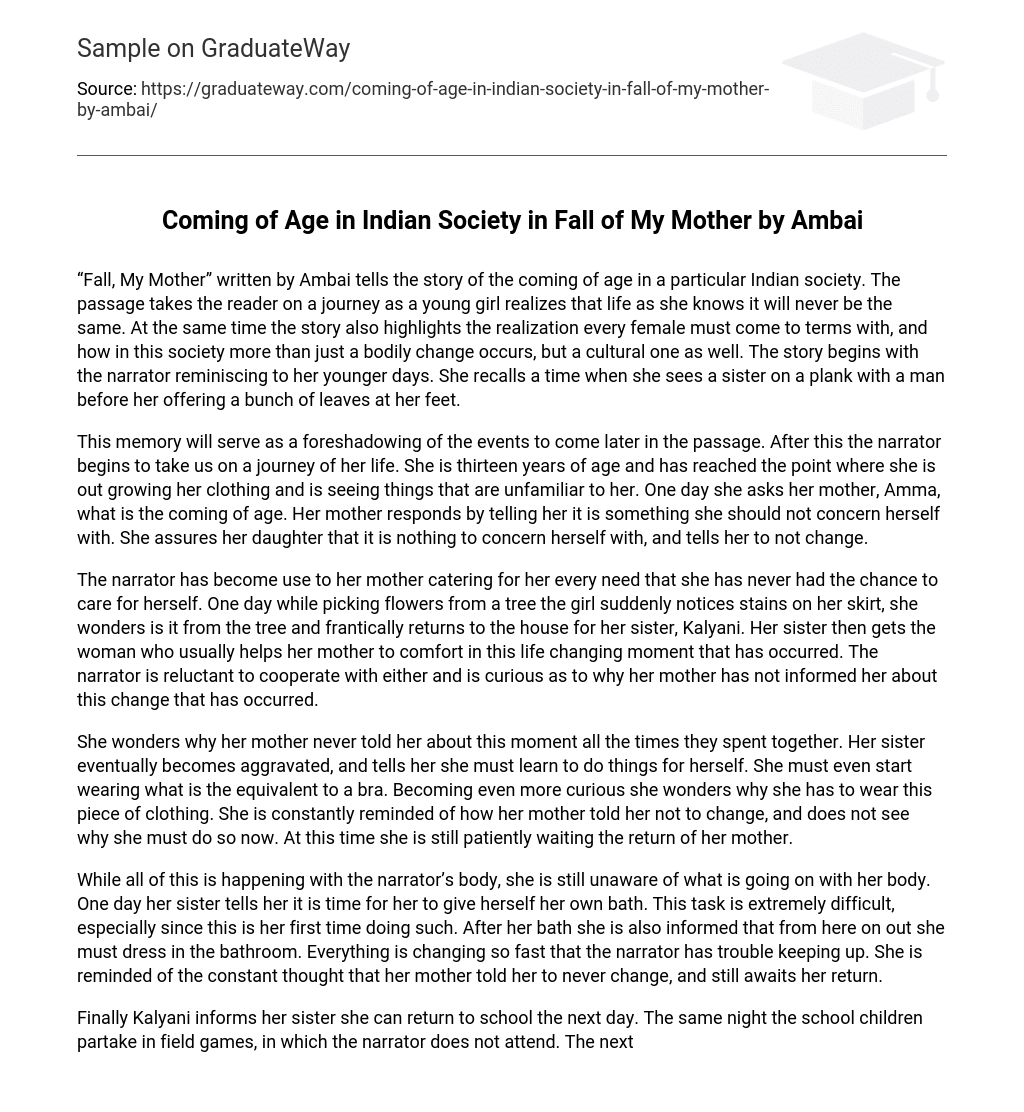“Fall, My Mother” written by Ambai tells the story of the coming of age in a particular Indian society. The passage takes the reader on a journey as a young girl realizes that life as she knows it will never be the same. At the same time the story also highlights the realization every female must come to terms with, and how in this society more than just a bodily change occurs, but a cultural one as well. The story begins with the narrator reminiscing to her younger days. She recalls a time when she sees a sister on a plank with a man before her offering a bunch of leaves at her feet.
This memory will serve as a foreshadowing of the events to come later in the passage. After this the narrator begins to take us on a journey of her life. She is thirteen years of age and has reached the point where she is out growing her clothing and is seeing things that are unfamiliar to her. One day she asks her mother, Amma, what is the coming of age. Her mother responds by telling her it is something she should not concern herself with. She assures her daughter that it is nothing to concern herself with, and tells her to not change.
The narrator has become use to her mother catering for her every need that she has never had the chance to care for herself. One day while picking flowers from a tree the girl suddenly notices stains on her skirt, she wonders is it from the tree and frantically returns to the house for her sister, Kalyani. Her sister then gets the woman who usually helps her mother to comfort in this life changing moment that has occurred. The narrator is reluctant to cooperate with either and is curious as to why her mother has not informed her about this change that has occurred.
She wonders why her mother never told her about this moment all the times they spent together. Her sister eventually becomes aggravated, and tells her she must learn to do things for herself. She must even start wearing what is the equivalent to a bra. Becoming even more curious she wonders why she has to wear this piece of clothing. She is constantly reminded of how her mother told her not to change, and does not see why she must do so now. At this time she is still patiently waiting the return of her mother.
While all of this is happening with the narrator’s body, she is still unaware of what is going on with her body. One day her sister tells her it is time for her to give herself her own bath. This task is extremely difficult, especially since this is her first time doing such. After her bath she is also informed that from here on out she must dress in the bathroom. Everything is changing so fast that the narrator has trouble keeping up. She is reminded of the constant thought that her mother told her to never change, and still awaits her return.
Finally Kalyani informs her sister she can return to school the next day. The same night the school children partake in field games, in which the narrator does not attend. The next day at school the teacher asks who did not attend the games. When called out on her absence the narrator said she did not stand because she is not a fool. This results in her receiving a mark of impertinent on her report card. The following morning the mother returns to the house. She reports the news that her niece was not accepted for marriage.
The mother is disappointed because she too has a dark-skinned daughter, and awaits the trouble ahead in the near future. The narrator at this time is wondering will her mother explain to her this mystery of what has happened. Her mother then catches a glimpse of her and tells her that she should stop complaining about what has happened, because now they have bigger problems on their hand. This final moment in the passage is linked to the beginning of the story. In this Indian culture the bride’s family is responsible for paying the dowry for her to be wed.
This means that the mother will have to pay a higher dowry because her daughter is dark-skinned meaning it will be harder to find a husband for her. This story represents the struggle women have to go through when experiencing the coming in age. Despite the fact that the coming of age in a young woman’s life is different in every society, the change that occurs is the same never the less. This passage makes one appreciate all that women have to go through, while presenting the cultural flaws in a particular society.





